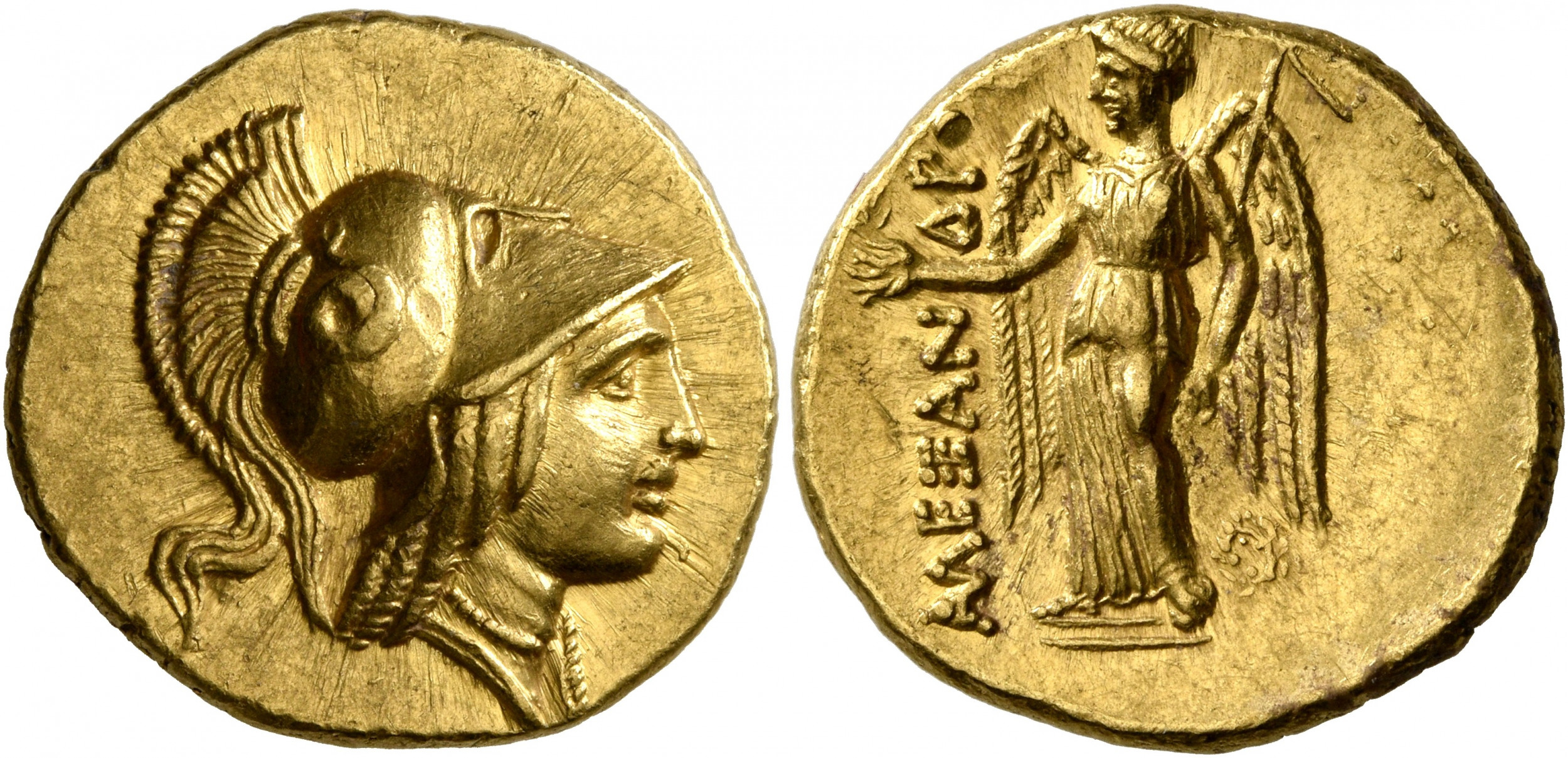S 36 - Aradus (Alexander the Great), gold, staters (332-320 BCE)
From SILVER
332 BCE - 320 BCE Gold 23,489 kg
Description
| ObverseInscription or printing placed on the obverse.: | Head of Athena to right, wearing crested Corinthian helmet decorated with a coiled serpent. |
| ReverseInscription or printing placed on the reverse.: | (BAΣΙΛΕΩΣ) ΑΛΕΞΑΝΔΡΟΥ (Greek).Nike standing front, head to left, with her wings spread, holding laurel wreath in her right hand and stylis in her left, to lower right, wreath. |
Mint and issuing power
| MintIdentifies the place of manufacture or issue of a numismatic object.: | Aradus | Ancient regionAncient region.: | Phoenicia | Modern countryModern country: Syria | AuthorityIdentifies the issuing power. The authority can be "pretended" when the name or the portrait of X is on the coin but he/she was not the issuing power. It can also be "uncertain" when there is no mention of X on the coin but he/she was the issuing power according to the historical sources: | Alexander III the Great (Argead king, 336-323 BC) |
Chronology
| FromIdentifies the initial date in a range assigned in a numismatic context. | 332 BCE | toIdentifies the final date in a range assigned in a numismatic context.. | 320 BCE | PeriodTime period of the numismatic object.: Classical and Hellenistic |
Physical description
| MetalThe physical material (usually metal) from which an object is made.: | Gold |
Median weightMedian of the weights of numismatic objects (in grams). in grams | 8.56 | DenominationTerm indicating the value of a numismatic object. Examples: tetradrachm, chalkous, denarius.: | stater |
StandardStandard.: | Attic |
Image

S36 aradus alexander staters.jpg [1]
References
| Die study referencePublication of the study: | Duyrat 20051Duyrat 2005, p. 15, n° 52-63 (Group III, Series 3 et Group IV, Series 1), p. 17, n° 137-164 (Group IV, Series 2-3) et p. 24-25, n° 539-549 (Group IV, Series 11) | ||
| Coin series referenceReference to coin series study: | HGC 102HGC 10, n° 58 | ||
| Coin series web referenceCoin series web references: | |||
Obverse dies distribution
| FrequencyFrequency of specimen in distribution. ᵖ | Number of obversesNumber of obverse dies. ᵖ (o) | % (o) | Number of coinsNumber of coins. (n) | % (n) | Die nameName(s) of the die(s). |
| 1 | 3 | 25 | 3 | 5.77 | 2, 4, 5 |
| 2 | 1 | 8.33 | 2 | 3.85 | 6 |
| 3 | 1 | 8.33 | 3 | 5.77 | 12 |
| 4 | 3 | 25 | 12 | 23.08 | 3, 10, 11 |
| 5 | 1 | 8.33 | 5 | 9.62 | 1 |
| 8 | 1 | 8.33 | 8 | 15.38 | 8 |
| 9 | 1 | 8.33 | 9 | 17.31 | 9 |
| 10 | 1 | 8.33 | 10 | 19.23 | 7 |
| Total | 12 of 12 | 99.98 | 52 of 52 | 100.01 |
Reverse dies distribution
no distribution is available
Quantification
| Number of obversesNumber of obverse dies. ᵖ (o) | 12 | Number of singletons (o1)The number of singleton coins. ᵖ | 3 |
| Number of reverse diesNumber of reverse dies. (r) | 21 | Number of coinsNumber of coins. (n) | 52 |
| Coins per obverse dieNumber of coins per obverse die. (n/o) | 4.33 | Coins per reverse dieNumber of coins per reverse die. (n/r) | 2.48 |
| Reverse per obverse ratioRatio of obverse dies divided by reverse dies. (r/o) | 1.75 | Percentage of singletons (o1)number of coins (n) divided by the number of singletons (o1) ᵖ | 25 % |
| Original number of dies (O) (Carter 1983 formula)The estimation of the number of coins according to Carter 1983 ᵖ | 13.72 | Coins struck if 20,000 as average productivity per dieCoins made if the average productivity for obverses (according to Carter) is 20,000. ᵖ | 274,400 |
| Original number of dies (O) (Esty 2011 formula)The estimation of the number of coins according to the singleton formula in Esty 2011 ᵖ (O) | 15.6 | Survival rate if 20,000 as average productivity per dieSurvival rate if average productivity is 20,000. ᵖ | 0.00019 |
| Coverage (o = % of O) (Esty 1984 formula)Esty 1984 - coverage (% of O) ᵖ (o = % of O) | 94.23% | Die productivity if survival rate 1/2,000Average productivity if survival rate is 1/2,000. ᵖ | 7,580.17 |
| Weight of silver (in kg) if 20,000 coins per die (O = Carter formula)Carter 1983 * Median weight * 20000 (*10 if gold or electrum) ᵖ | 23,489 kg <br /> 23,489 kg | Die productivity if survival rate 1/5,000Average productivity if survival rate is 1/5,000. ᵖ | 18,950.44 |
Remarks